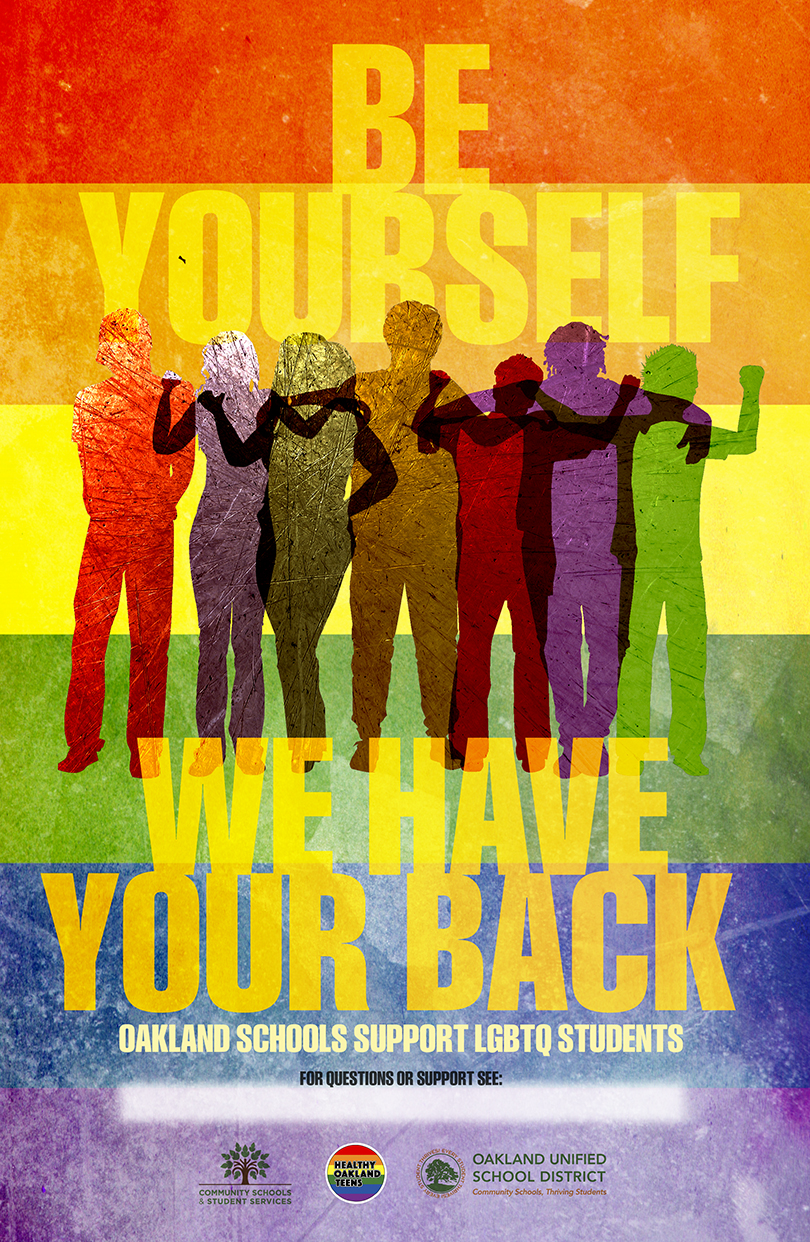Just two years ago, there were only a handful of Gay-Straight Alliances (GSAs) in Oakland Unified School District (OUSD). Now there are 24 GSAs, one in every middle and high school, except for two sites. Most recently, Community Schools and Student Services held their second—and hopefully annual—GSA Day. On this day, GSA groups from across the district at the middle- and high-school levels came together to forge community and greater connection. Over half of the school sites were in attendance with a total of 130 students, up from 80 last year.
Organizers Ilsa Bertolini, who heads up the district’s HIV-prevention program, and Olivia Higgins, a consultant with Queerly Elementary, launched the day with a special visit from Cheer San Francisco. Then students and their teacher-advisors attended workshops created and facilitated by students, like “Gender 101.” They had the opportunity to make celebratory posters to take back to their school sites or to write letters to their school leaders about changes they wanted to enact in service of greater support of LGBT youth. Additionally, each school site had the opportunity to share in science-fair style what they had been working on within their individual school-site GSA group. The highlight of the day, however, was the impromptu dance party the students created during lunch.
The dance party underscores what was so powerful about GSA Day. Identifying as an LGBT youth can feel isolating. Being part of a GSA on campus can help alleviate that feeling, but coming together as part of a larger community was something that many participants had never experienced. Collectively, students cited feeling “accepted,” “safe” and “comfortable.” Teachers who chaperoned the event and serve as LGBT liaisons back at their respective campuses had positive reflections, too. One high school teacher said, “The GSA Day was a wonderful place for my students to interact with LGBT and ally students outside of their usual communities. … It helped show students they are part of a larger supportive community in Oakland.” For one particular student, the impact of that larger community was summed up when they wrote that the day was “the best day of my life.”
With help from a grant from the Centers for Disease Control and Prevention, OUSD hopes to find more ways to support its LGBT youth and their allies. Community Schools and Student Services personnel are positioned to provide resources in advance of need, rather than only responding in crisis, a big shift in recent years. For example, during the 2014-15 school year, the district provided stipends for LGBT liaisons at all middle and high school sites for the first time. Previously, site-based GSAs were mostly independent and voluntary endeavors, instead of safe spaces that all schools could provide. Having an adult ally to help create these safe spaces is essential.
According to one of the liaisons, “I witnessed firsthand how crucial a supportive community is for positive gender and sexual identity development.” Liaisons themselves are now getting support in the community, too, as Community Schools and Student Services is offering the cohort of adult LGBT liaisons quarterly meetings, online resources and more help as needed.
This work is imperative, even without the kind of grant OUSD has secured. Bertolini emphasized that supporting LGBT youth needs to move forward even if a school district doesn’t think it has the money. Different departments have overlapping interests and funding sources, and LGBT issues are deeply connected to health education and restorative justice, among others. Bertolini advises “leveraging” funding from existing sources and building cross-departmental alliances. “It’s really just about finding in your district who is a stakeholder for supporting LGBT youth in schools,” she suggests.
Putting on a GSA Day requires “lots of time, energy, money, and it’s worth it,” Higgins adds. “Of all of the things we do to support our GSAs, this is the number one thing that we do. Even if only five students show up, it’s absolutely worth it. … We are giving them a sense of community that is beyond just their school site. That’s a huge opportunity and gift.”
Editor’s note: For more information on establishing a GSA at your school, check out “10 Tips for Starting a GSA.”
Thomas is a former English teacher turned instructional coach in Oakland, California.

0 COMMENTS